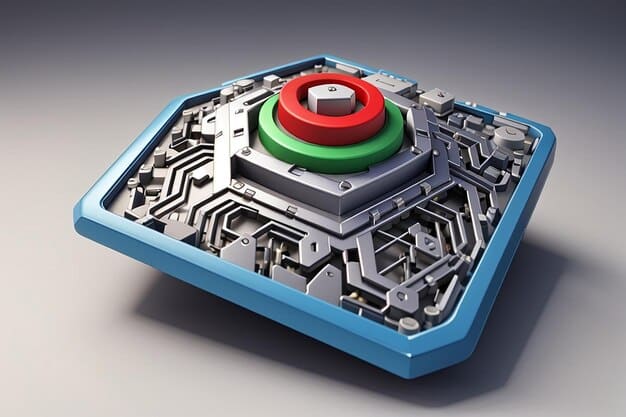Xbox Series X Refresh in 2025: Will it Boost Frame Rates by 15%?

The prospect of a new Xbox Series X refresh in 2025 potentially boosting frame rates by 15% is a significant topic among gamers, driven by speculative leaks and the console cycle’s natural evolution toward enhanced performance and efficiency, rather than a definitive confirmation from Microsoft.
The gaming community is abuzz with speculation: Will the new Xbox Series X refresh boost frame rates by 15% in 2025? This question taps into the perpetual desire for improved performance and a more immersive gaming experience. As technology rapidly evolves, mid-generation console refreshes have become a standard practice, offering incremental yet often impactful upgrades. For Xbox enthusiasts, the idea of a more powerful Series X, even a modest 15% enhancement in frame rates, represents a tantalizing possibility that could redefine their gaming sessions over the next few years.
the context of console refreshes: a mid-gen tradition
Console refreshes are not a new phenomenon. From the PlayStation 4 Pro to the Xbox One X, manufacturers have consistently released updated versions of their flagship consoles to bridge the gap between generations. These refreshes typically offer improved graphical capabilities, faster processing, and sometimes, enhanced frame rates. The intention is to prolong the console’s lifecycle, maintain consumer interest, and ensure new games can utilize more advanced hardware without necessitating a complete generational leap.
The current console generation, featuring the Xbox Series X and PlayStation 5, launched in late 2020. By 2025, these consoles will be half a decade old, a prime time for a mid-generation refresh. This pattern aligns with historical trends, making the notion of a new Xbox Series X refresh a highly plausible development. While official announcements are scarce, the industry often telegraphs these moves through various channels, from patent filings to supply chain rumors.
evolution of console hardware
Console hardware has undergone a remarkable transformation over the decades. What began as dedicated gaming machines with static specifications now often includes components that can be iteratively improved. CPUs and GPUs, the powerhouse elements, continually miniaturize and become more efficient, allowing for performance boosts within similar form factors. This technological march makes refreshes a natural evolution.
- Improved CPU clock speeds: A common upgrade in refreshes.
- Enhanced GPU performance: Allowing for higher resolutions or frame rates.
- More efficient cooling solutions: Enabling sustained performance.
- Faster memory: Reducing loading times and improving data handling.
Understanding this historical and technological context is crucial when evaluating the likelihood of a 15% frame rate boost. Such an improvement, while significant, isn’t unprecedented for a mid-gen upgrade, especially when leveraging more refined manufacturing processes for existing architectures.
The mid-generation refresh strategy serves multiple purposes for console manufacturers. It allows them to introduce new technology without fragmenting the player base too drastically, as new games typically remain compatible across both original and refreshed models. Furthermore, it provides an opportunity to address early production challenges and optimize manufacturing costs, potentially leading to a more robust and cost-effective product for consumers.
deciphering the 15% frame rate boost: realism vs. speculation
The specific figure of a 15% frame rate boost circulating in the rumor mill needs careful examination. Is this a realistic expectation for a console refresh, or mere wishful thinking? Historically, mid-generation improvements have varied. Some refreshes offered substantial leaps, primarily in resolution, while others provided more modest performance gains. A 15% increase, while noticeable, isn’t a monumental leap that would redefine gaming, but it’s certainly a welcome enhancement.
Achieving a 15% boost can come from several improvements:
potential hardware enhancements
- Die shrink: Moving to a smaller manufacturing process (e.g., from 7nm to 5nm) can significantly increase transistor density and efficiency, leading to higher clock speeds and lower power consumption.
- Optimized architecture: Minor tweaks to the existing RDNA 2 architecture (or potentially a jump to RDNA 3 variants) could unlock hidden performance without a complete redesign.
- Faster memory sub-system: Improving the speed or bandwidth of GDDR6 memory could alleviate bottlenecks, allowing the CPU and GPU to process data more quickly.
These hardware upgrades, individually or combined, could incrementally push frame rates. However, game developers also play a crucial role. Not all games are optimized to fully exploit minor hardware changes, meaning the 15% boost might only be realized in titles specifically patched or developed with the refresh in mind.
Another factor is the target resolution. If the current Series X is already pushing 4K, a 15% frame rate increase might be difficult without significant hardware changes. If the target is 1440p or 1080p, then a 15% boost is more achievable. It’s about balancing power with the desired visual fidelity and performance targets set by developers.
The term “frame rate boost” itself can be ambiguous. Does it refer to a consistent 15% increase across all titles, or an average increase in some games, or better stability in demanding scenes? These nuances are important when managing expectations. A consistent 15% across all titles without any developer intervention is highly unlikely; rather, it would likely translate to better performance in specific scenarios or in new games optimized for the updated hardware.

microsoft’s strategy: performance, design, and market position
Microsoft’s approach to its console strategy involves a multi-faceted consideration of performance, design, and market positioning. A Series X refresh in 2025 would likely align with these broader company goals, aiming to keep the Xbox brand competitive and appealing to a diverse gamer base. Such a refresh isn’t just about raw power; it’s also about refining the user experience.
the role of design and form factor
Beyond internal components, console refreshes often include design alterations. While the rumored refresh might retain the internal power of the current Series X, there’s always a possibility of a more compact, sleeker design. A smaller form factor could appeal to consumers with limited space or those who prefer a less imposing central entertainment unit. Efficiency breakthroughs in cooling or power delivery could enable such design changes without compromising performance.
- More compact chassis: Reducing the console’s footprint.
- Improved thermal management: Quieter operation and better heat dissipation.
- Minor aesthetic updates: Refined finishes or new color options.
These design improvements, though not directly related to frame rates, contribute significantly to the overall appeal and perceived value of a new console. A more attractive and user-friendly design can be a powerful marketing tool, especially in a competitive market.
Microsoft has consistently shown a commitment to evolving its hardware. Remember the original Xbox, which was a massive black box, compared to the sleek designs of later generations. Each iteration has seen refinements in aesthetics, noise levels, and overall build quality. A 2025 refresh would undoubtedly continue this trend, perhaps embracing more sustainable materials or modular designs for easier repairs or upgrades down the line.
Furthermore, the design could influence the location of the console within a consumer’s home. A smaller, quieter console is more likely to be placed prominently, enhancing its integration into a modern living room setup. This holistic approach to console development ensures that the product appeals not just to the hardcore enthusiast, but also to the broader mainstream consumer.
the impact on game developers and the xbox ecosystem
A refreshed Xbox Series X would have significant implications for game developers and the broader Xbox ecosystem. While a 15% frame rate boost might seem minimal, it could offer developers more headroom to push visual fidelity, maintain stable frame rates in demanding titles, or even experiment with new graphical techniques. This extra performance can be a valuable asset in creating more immersive and visually stunning games.
developer flexibility and optimization
For developers, a console refresh typically means they have a new target specification to optimize for. While cross-compatibility with the original Series X would be paramount, the enhanced version could allow them to offer “performance modes” that truly shine. This could mean stable 60fps at higher resolutions, or even a push towards 120fps in more games.
- Enhanced graphic options: Allowing for denser environments or more complex effects.
- More stable performance: Reducing frame drops in intense scenes.
- Potentially higher resolutions: Pushing closer to native 4K with fewer compromises.
The existence of a more powerful model can also influence future game development. If developers know a significant portion of the user base will own the refreshed console, they might aim for higher performance benchmarks, driving innovation across the entire ecosystem.
The Xbox ecosystem includes Game Pass, Microsoft’s subscription service. A more powerful console could further enhance the value proposition of Game Pass, especially if games streamed via the cloud (xCloud) also benefit from the improved hardware on the server side. A better core console experience can only bolster the appeal of these complementary services.
Moreover, developers could potentially offer enhanced updates for existing titles, unlocking the additional performance of the refresh for games already on the market. This backward compatibility with forward-looking enhancements is a key selling point for console refreshes, allowing players to revisit their favorite games with new graphical fidelity or performance. The incremental power gain offers a smoother transition than an entirely new generation, minimizing developer re-tooling.
economic factors and market competition
The decision to launch an Xbox Series X refresh in 2025, and its specifications, will undoubtedly be influenced by broader economic factors and the competitive landscape. Inflation, global supply chain issues, and consumer spending habits all play a role. Furthermore, the actions of competitors, primarily Sony with its PlayStation offerings, will heavily factor into Microsoft’s strategy.
pricing and consumer adoption
The price point of a refreshed console is critical. If it’s too expensive, consumer adoption could be slow. If it’s priced competitively, it could invigorate sales. Balancing new hardware, manufacturing costs, and market demand is a delicate act. A 15% frame rate boost might not justify a significantly higher price tag for many consumers unless it’s bundled with other compelling features or a more attractive design.
- Competitive pricing: Essential for market penetration.
- Bundle options: Offering games or accessories to sweeten the deal.
- Trade-in programs: Encouraging current owners to upgrade.
Microsoft’s overarching goal isn’t just to sell hardware, but to grow the Xbox ecosystem. A successful refresh drives Game Pass subscriptions, software sales, and accessories, fostering a healthy long-term revenue stream for the company.
The global economic climate in 2025 will be a significant determinant. If consumer disposable income remains strained, even a highly anticipated console refresh might face headwinds. Microsoft would need a compelling value proposition that resonates with a broad audience, ensuring the perceived benefits of the refresh outweigh its cost. This dynamic interplay between innovation and affordability is at the heart of any successful product launch in the consumer electronics sector.
the community’s perspective: hopes, expectations, and controversies
The gaming community is a vibrant and vocal group, and any talk of a console refresh inevitably ignites a flurry of hopes, expectations, and sometimes, controversies. The prospect of a 15% frame rate boost specifically for the Xbox Series X is no exception, stirring debate among enthusiasts and casual players alike.
managed expectations vs. hype
One of the biggest challenges for console manufacturers is managing community expectations. Leaks and rumors, while exciting, often create unrealistic projections. A 15% frame rate boost, if confirmed, would be a solid enhancement, but it’s crucial for the community to understand what that truly means in terms of everyday gaming. It should not be oversold as a revolutionary leap, but rather as a significant iterative improvement.
- Focus on tangible benefits: Better stability, smoother gameplay.
- Avoid exaggerated marketing: Preventing disappointment post-launch.
- Clear communication: Explaining how the refresh benefits different game types.
However, the hype train is hard to stop. The desire for “more power” is deeply ingrained in the gaming psyche. A refresh provides an outlet for that desire, but it also carries the risk of backlash if the delivered performance doesn’t match the community’s highest hopes. Microsoft will need to carefully navigate this landscape with transparent and honest communication.
The gaming community also scrutinizes perceived hardware parity between Xbox and PlayStation. If Sony delivers a more substantial mid-gen refresh, Microsoft’s offering might be seen as less impactful, regardless of its actual performance gains. This competitive dynamic often fuels heated debates online, making community perception a critical factor in the success of any console refresh.
Another point of contention might be the potential for exclusive features or performance modes on the refreshed console, creating a two-tiered experience within the same generation. While developers typically avoid this to maintain a unified player base, more aggressive hardware differentiation could lead to frustration for owners of the original Series X. Clear messaging around cross-generational compatibility and performance profiles will be essential to mitigate such concerns and preserve community goodwill.

looking ahead: what factors will determine the ‘15% boost’?
The ultimate realization of a 15% frame rate boost for a new Xbox Series X refresh in 2025 depends on a confluence of strategic, technological, and market factors. It’s not a singular decision but rather an outcome of complex interplay. Several key elements will determine whether this rumored performance increase becomes a reality and how it is perceived by the global gaming community.
the interplay of software and hardware
Crucially, hardware enhancements, even significant ones, are only as effective as the software designed to leverage them. A new Series X could offer a 15% raw processing boost, but if games aren’t optimized to tap into that additional power efficiently, the real-world frame rate gains might be less pronounced or inconsistent. Developers will play a pivotal role in showcasing any such improvements.
- Optimized game engines: Key to translating raw power into tangible frame rates.
- Developer adoption: Willingness of studios to target the refreshed hardware.
- Middleware improvements: Tools that help developers utilize new features efficiently.
Furthermore, Microsoft’s DirectX API and its continuous evolution will be critical. Enhancements to the software stack that runs the console can often unlock performance gains even without radical hardware changes, or significantly magnify the impact of minor hardware tweaks. Therefore, the “15% boost” will be a joint achievement of hardware engineering and software optimization efforts.
The timing of game releases relative to a console refresh is also important. If major first-party titles launch shortly after the refresh, they can serve as powerful showcases for the new capabilities, much like launch titles do for a new generation. This synergy between new hardware and compelling software is essential for demonstrating the value of any performance upgrade.
Finally, the competitive landscape with Sony’s PlayStation will undoubtedly influence Microsoft’s strategy. If a PlayStation 5 Pro offers a larger performance leap, Microsoft might feel pressured to deliver more than a mere 15% to remain competitive, perhaps even pushing architectural changes beyond simple die缩小. Conversely, a more conservative approach from Sony could allow Microsoft to validate a more modest, efficiency-focused upgrade.
| Key Point | Brief Description |
|---|---|
| 🎮 Mid-Gen Refresh Expected | A refresh in 2025 aligns with historical console cycles for performance and efficiency upgrades. |
| 🚀 15% Frame Rate Boost | A realistic, though unconfirmed, target for significant performance gains via hardware tweaks. |
| 💡 Hardware Enhancements | Likely to involve die shrinks, architectural optimizations, and faster memory. |
| 🤝 Developer Impact | Could provide more headroom for stable performance and enhanced graphical options for games. |
frequently asked questions
No, as of now, Microsoft has not officially confirmed an Xbox Series X refresh for 2025. Discussions and rumors surrounding a mid-generation console upgrade are entirely based on leaks, industry patterns, and speculative reports, rather than any definitive statement from the company or its representatives.
A 15% frame rate boost, while not a generational leap, could lead to noticeably smoother gameplay, particularly in visually demanding titles or scenes. It could help maintain stable frame rates closer to target (e.g., a more consistent 60fps), reduce dips during intense action, and potentially allow for higher resolution scaling in some games.
Potential hardware changes include a die shrink of the existing AMD chip (e.g., from 7nm to 5nm), allowing for higher clock speeds and better efficiency. Minor architectural tweaks to the CPU/GPU, improved memory bandwidth, or more advanced cooling solutions to sustain peak performance could also contribute to a 15% frame rate improvement.
Yes, many existing games would likely benefit. Titles that currently struggle to maintain their target frame rates or resolutions could see improved stability and performance on the refreshed hardware. Some developers might also release specific “performance patches” to fully leverage the new console’s capabilities, offering enhanced graphics or higher frame rate modes.
A more powerful Xbox Series X refresh could enhance the Game Pass experience by ensuring games, especially new first-party titles, run at their best. It would reinforce the value of the subscription service by showcasing its diverse library on optimal hardware, potentially attracting new subscribers and retaining existing ones through superior performance.
conclusion
The question of whether a new Xbox Series X refresh in 2025 will deliver a 15% boost in frame rates remains in the realm of informed speculation. However, the technological trajectory of console development, coupled with industry patterns of mid-generational upgrades, makes it a highly plausible scenario. Such an improvement, while not revolutionary, would be a significant enhancement for gamers, offering smoother experiences and potentially allowing developers more creative freedom. As we approach 2025, the gaming community will undoubtedly be keenly watching for official announcements from Microsoft, eager to see if their performance desires become a tangible reality.





